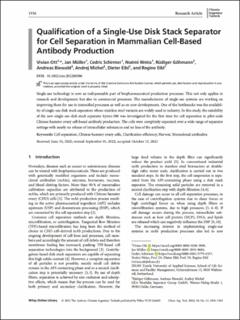Please use this identifier to cite or link to this item:
https://doi.org/10.21256/zhaw-26259| Publication type: | Article in scientific journal |
| Type of review: | Peer review (publication) |
| Title: | Qualification of a single‐use disk stack separator for cell separation in mammalian cell‐based antibody production |
| Authors: | Ott, Vivian Müller, Jan Schirmer, Cedric Weiss, Noémi Göhmann, Rüdiger Biewald, Andreas Michel, Andrej Eibl, Dieter Eibl-Schindler, Regine |
| et. al: | No |
| DOI: | 10.1002/cite.202200096 10.21256/zhaw-26259 |
| Published in: | Chemie Ingenieur Technik |
| Volume(Issue): | 94 |
| Issue: | 12 |
| Page(s): | 1936 |
| Pages to: | 1943 |
| Issue Date: | 2022 |
| Publisher / Ed. Institution: | Wiley |
| ISSN: | 0009-286X 1522-2640 |
| Language: | English |
| Subjects: | Cell separation; Chinese hamster ovary cell; Clarification efficiency; Harvest, Monoclonal antibody |
| Subject (DDC): | 660.6: Biotechnology |
| Abstract: | Single-use technology is now an indispensable part of biopharmaceutical production processes. This not only applies to research and development, but also to commercial processes. The manufacturers of single-use systems are working on improving them for use in intensified processes as well as on new developments. One of the bottlenecks was the availability of single-use disk stack separators whose stainless steel variants are widely used in industry. In this study, the suitability of the new single-use disk stack separator kytero 500 was investigated for the first time for cell separation in pilot-scale Chinese hamster ovary cell-based antibody production. The cells were completely separated over a wide range of separator settings with nearly no release of intracellular substances and no loss of the antibody. |
| URI: | https://digitalcollection.zhaw.ch/handle/11475/26259 |
| Fulltext version: | Published version |
| License (according to publishing contract): | CC BY 4.0: Attribution 4.0 International |
| Departement: | Life Sciences and Facility Management |
| Organisational Unit: | Institute of Chemistry and Biotechnology (ICBT) |
| Published as part of the ZHAW project: | Evaluation of cell separation using the GEA kytero® Single Use Pharma Separator with disk stack technology |
| Appears in collections: | Publikationen Life Sciences und Facility Management |
Files in This Item:
| File | Description | Size | Format | |
|---|---|---|---|---|
| 2022_Ott-etal_Qualification-single‐use-disk-stack-separator-cell-separation-mammalian.pdf | 2.46 MB | Adobe PDF |  View/Open |
Show full item record
Ott, V., Müller, J., Schirmer, C., Weiss, N., Göhmann, R., Biewald, A., Michel, A., Eibl, D., & Eibl-Schindler, R. (2022). Qualification of a single‐use disk stack separator for cell separation in mammalian cell‐based antibody production. Chemie Ingenieur Technik, 94(12), 1936–1943. https://doi.org/10.1002/cite.202200096
Ott, V. et al. (2022) ‘Qualification of a single‐use disk stack separator for cell separation in mammalian cell‐based antibody production’, Chemie Ingenieur Technik, 94(12), pp. 1936–1943. Available at: https://doi.org/10.1002/cite.202200096.
V. Ott et al., “Qualification of a single‐use disk stack separator for cell separation in mammalian cell‐based antibody production,” Chemie Ingenieur Technik, vol. 94, no. 12, pp. 1936–1943, 2022, doi: 10.1002/cite.202200096.
OTT, Vivian, Jan MÜLLER, Cedric SCHIRMER, Noémi WEISS, Rüdiger GÖHMANN, Andreas BIEWALD, Andrej MICHEL, Dieter EIBL und Regine EIBL-SCHINDLER, 2022. Qualification of a single‐use disk stack separator for cell separation in mammalian cell‐based antibody production. Chemie Ingenieur Technik. 2022. Bd. 94, Nr. 12, S. 1936–1943. DOI 10.1002/cite.202200096
Ott, Vivian, Jan Müller, Cedric Schirmer, Noémi Weiss, Rüdiger Göhmann, Andreas Biewald, Andrej Michel, Dieter Eibl, and Regine Eibl-Schindler. 2022. “Qualification of a Single‐Use Disk Stack Separator for Cell Separation in Mammalian Cell‐Based Antibody Production.” Chemie Ingenieur Technik 94 (12): 1936–43. https://doi.org/10.1002/cite.202200096.
Ott, Vivian, et al. “Qualification of a Single‐Use Disk Stack Separator for Cell Separation in Mammalian Cell‐Based Antibody Production.” Chemie Ingenieur Technik, vol. 94, no. 12, 2022, pp. 1936–43, https://doi.org/10.1002/cite.202200096.
Items in DSpace are protected by copyright, with all rights reserved, unless otherwise indicated.